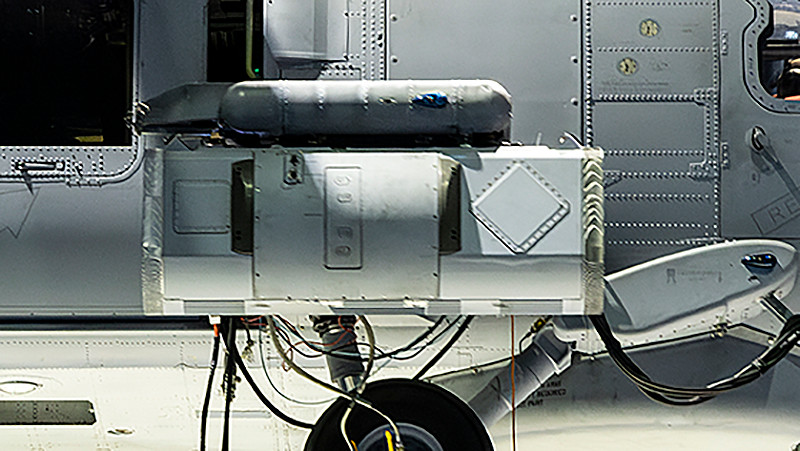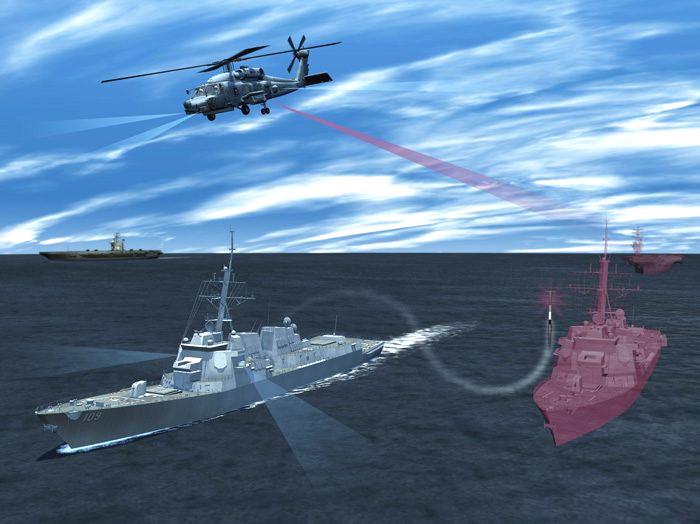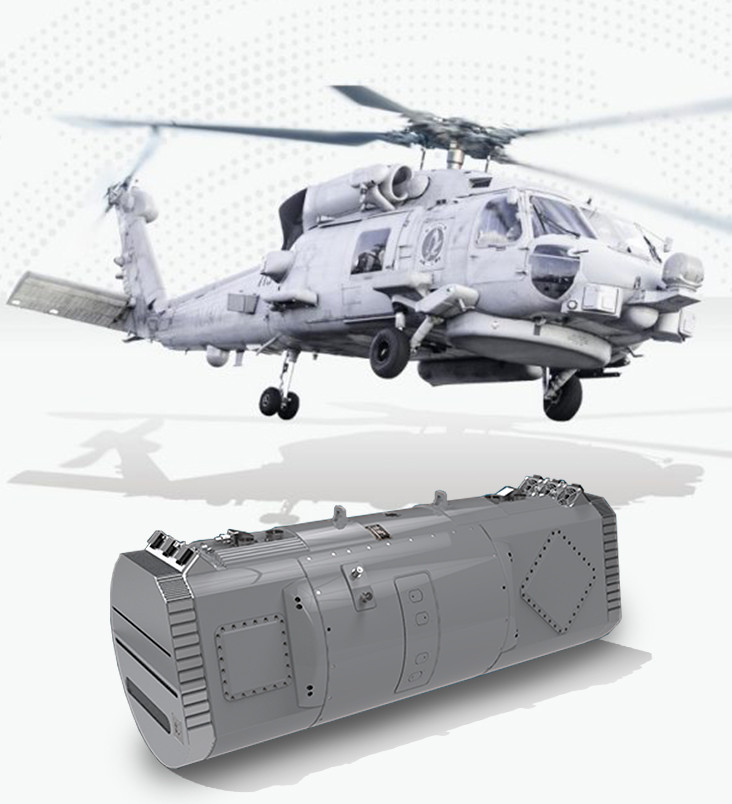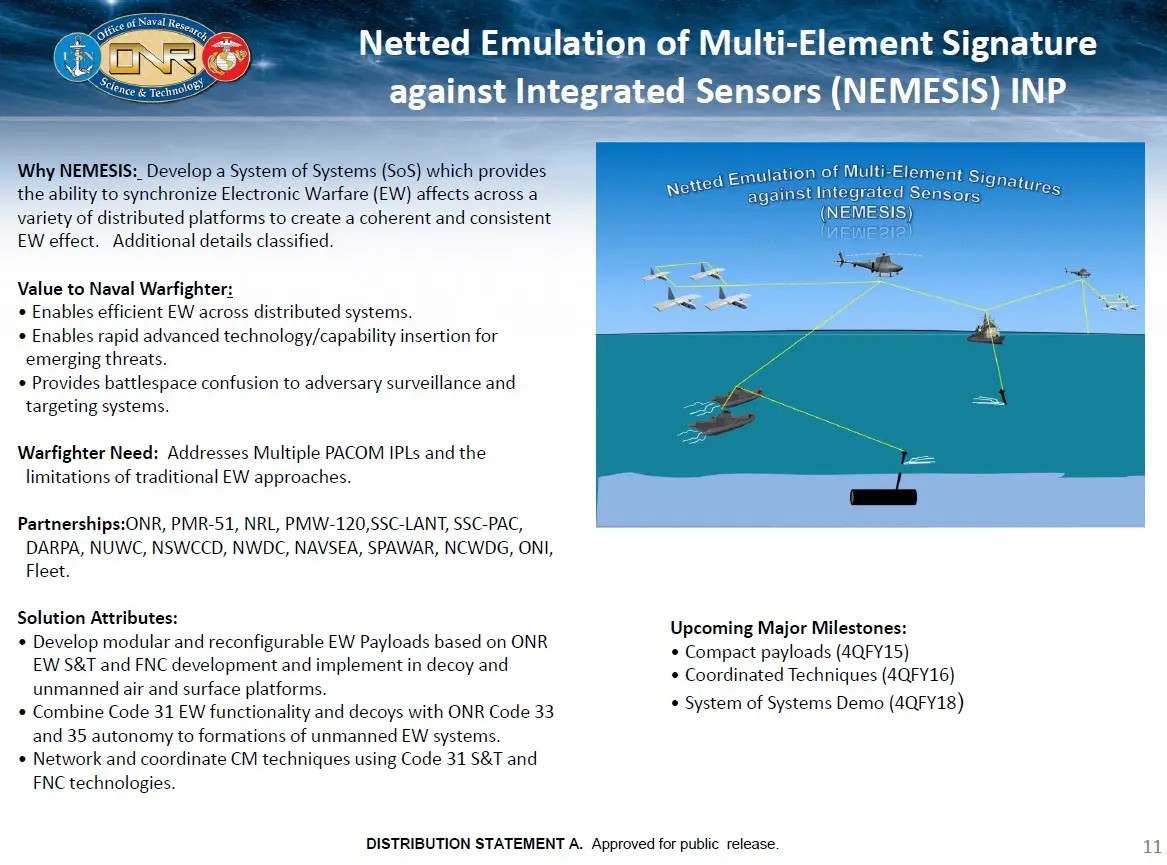The U.S. Navy is one step closer to acquiring a new distributed electronic warfare capability to defeat anti-ship missiles heading toward its ships thanks to a recent test. The Advanced Off-Board Electronic Warfare system, or AOEW, a pod that MH-60R and MH-60S Seahawk helicopters can carry, has now demonstrated its basic ability to engage and defeat the required threats, at least in a controlled environment.
Lockheed Martin, AOEW’s prime contractor, announced the successful completion of the milestone test, which took place at Naval Air Station Patuxent River, earlier today. The company’s press release was accompanied by pictures from the Navy showing an MH-60R helicopter with the AOEW pod, also known as the AN/ALQ-248, suspended inside the anechoic test chamber at Patuxent River.

Anechoic chambers provide spaces free of ambient electromagnetic radiation that allow for very accurate testing of how various electronic systems onboard an aircraft might interact (or interfere, and in potentially dangerous ways) with each other. By extension, they also offer a way to demonstrate the core functionality of things like electronic warfare systems by showing that they emit their signals as expected.

The test of the AOEW pod at Patuxent River specifically “marked the first time in the program’s development the system was able to perform engagement testing, demonstrate the ability to defeat threats, and quantify system performance, while integrated [on] and controlled” from the MH-60R, according to Lockheed Martin. Though the MH-60R was used in this particular test, the Navy plans to field the AN/ALQ-248 on MH-60S helicopters, as well.

“The AOEW system is one of the most advanced, complex electronic warfare systems ever developed,” Deon Viergutz, vice president of Spectrum Convergence at Lockheed Martin, said in a statement in today’s press release about the recent test. “AOEW is a force multiplier for our Sailors that will help them dominate and control the battlespace without ever firing a single shot. It is designed with evolutionary capabilities, set up to be completely programmable so that it can develop, deliver and deploy new techniques as the threat landscape changes.”
More specific details about the AN/ALQ-248 design and how it works are limited. Lockheed Martin has said in the past that the system is designed to provide “persistent electronic surveillance (detection) and attack (countermeasure) capability.”

Despite it being a podded store, the Navy has described the AOEW pod previously as a “long duration off-board decoy with onboard systems for EW [electronic warfare] coordination to counter identified [but classified] EW gaps … in response to an urgent operational need from the Fleet.”
The original core objective of the AOEW program, which dates back to 2011, was to “develop, procure and deploy multiple ship-launched, long duration platforms equipped with active or passive EW payloads for use in coordination with onboard EW systems to enhance battle group protection against current and future anti-ship missile (ASM) threats.”
AOEW-related concept art Lockheed Martin has released in the past also depicts the pod ‘projecting’ a silhouette of a friendly warship.

So, electronically presenting false targets to actively confuse or even potentially lure those threats away from friendly vessels looks to be one of the AN/ALQ-248’s core capabilities. Other electronic warfare and sensing capabilities aimed at detecting and primarily disrupting anti-ship missile attacks are also likely to be in its repertoire. If it features active electronic scanned antenna arrays, or AESAs, it could have much broader electronic warfare functionality, as well as potential additional surveillance capabilities and even the ability to act as a communications relay.

The immediate focus on anti-ship missile defense is hardly surprising. This has been an area of major concern for the Navy for years now and has already prompted the rapid development and fielding of a number of interim systems in recent years to help protect the service’s ships against these threats. This is on top of expendable decoys (like the U.S.-Australian Nulka) and electronic warfare suites, not to mention surface-to-air missiles and close-in defense systems, already in service.

Anti-ship missile threats are only continuing to expand and evolve, too, with Russia and China both working to field hypersonic types. China’s People’s Liberation Army (PLAN) also has a growing arsenal of anti-ship ballistic missiles. Increasingly advanced subsonic and supersonic anti-ship cruise missiles are also being developed and fielded around the world. Anti-ship missile capabilities have been steadily proliferating, as well, even to non-state groups.
Just yesterday, Iranian-backed Houthi militants attacked a commercial ship in the Red Sea with an anti-ship cruise missile, underscoring how real this threat is now. The Houthis have been launching missile and drone attacks toward ships in the region for weeks now in retaliation for Israel’s ongoing military intervention in the Gaza Strip. The Yemeni group has demonstrated its capability and willingness to launch missile attacks against foreign warships, including those belonging to the U.S. Navy, and commercial vessels on multiple occasions in the past too.
Whatever its capabilities are now, “AOEW leverages open-systems architected solutions, allowing for rapid upgrades, interoperability, reduced lifecycle costs and prompt insertion of new hardware,” according to Lockheed Martin.
Lockheed Martin also says that the AN/ALQ-248 “can be fully integrated with [the] Aegis Baseline 9C.2+ [combat system] and the Surface Warfare Electronic Warfare Improvement Program Block II [SEWIP Block II]” and that “the [AOEW] system can work independently or with other systems onboard ships and other assets.”
Integration with Aegis and SEWIP Block II, as well as other assets connected to Aegis, such as E-2D Hawkeye airborne early warning and control aircraft and other surface combatants, would allow for the feeding of data into AN/ALQ-248 and vice versa. This could help the entire network spot threats and then cooperatively target them with the appropriate countermeasure emissions, as well as other defensive systems, and do so faster and with greater precision across a broader area. As part of a larger networked electronic warfare ecosystem, AOEW also provides valuable distributed and elevated electronics warfare nodes with longer line-of-sight than existing shipboard electronic warfare capabilities.
You can read more about Aegis in this past War Zone feature. You can also learn more about SEWIP Block II in the context of its even more capable successor, SEWIP Block III, here.

Lockheed Martin says that the AOEW, or components thereof, could be adaptable to other formats for other platforms, such as “small ships or unmanned aerial and surface vehicles,” too.
What is particularly interesting about all of this is how much that vision of a distributed network of AOEW nodes in the air and down below, coupled with other systems like Aegis and SEWIP, aligns with a broader and secretive electronic warfare ecosystem the Navy has been known to be working for the past decade or so at least. The War Zone was the first to really report on this concept, which the Navy has referred to in the past as Netted Emulation of Multi-Element Signature against Integrated Sensors, or NEMSIS.
As The War Zone has written previously:
“The Navy has been developing and integrating multiple types of unmanned vehicles, shipboard and submarine systems, countermeasures and electronic warfare payloads, and communication technologies to give it the ability to project what is, in essence, phantom fleets of aircraft, ships, and submarines. These realistic-looking false signatures and decoys have the ability to appear seamlessly across disparate and geographically separated enemy sensor systems located both above and below the ocean’s surface. As a result, this networked and cooperative electronic warfare concept brings an unprecedented level of guileful fidelity to the fight. It’s not just about disrupting the enemy’s capabilities or confusing them at a command and control level, but also about making their sensors tell them the same falsehoods across large swathes of the battlespace.”
“Another way of looking at it is NEMESIS shifts from traditional electronic warfare tactics, in which multiple electronic warfare systems execute individual electronic attacks on multiple enemy sensors to achieve largely individual or localized effects, to a very diverse set of networked electronic warfare systems cooperatively making electronic attacks on huge portions of an enemy’s sensor network. That network may stretch across large distances and multiple warfighting domains. In doing so, it achieves a cohesive set of far more unified, powerful, and convincing effects.”

Even just by themselves, AN/ALQ-248 pods carried MH-60R and MH-60S helicopters flying from a variety of Navy ships will be able to significantly extend the electronic warfare bubble around carrier strike groups and other surface action groups, as well as individual ships or even critical sites ashore.
Lockheed Martin says the goal now is to begin delivering the first batch of low-rate initial production AOEW pods in the coming year. More testing to keep refining the AN/ALQ-248’s capabilities is also already planned for 2024.
Altogether, the recent test of the AOEW pod at Patuxent River is an important milestone for that particular program and the defense of Navy ships against anti-ship missiles, but also reflects the service’s broader electronic warfare ambitions.
Contact the author: joe@thedrive.com
